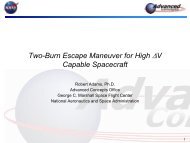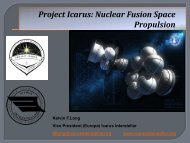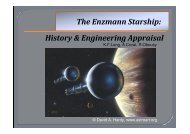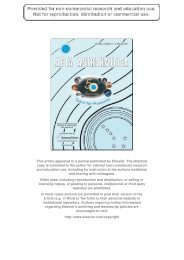Antimatter Catalyzed Fusion Propulsion For ... - Icarus Interstellar
Antimatter Catalyzed Fusion Propulsion For ... - Icarus Interstellar
Antimatter Catalyzed Fusion Propulsion For ... - Icarus Interstellar
Create successful ePaper yourself
Turn your PDF publications into a flip-book with our unique Google optimized e-Paper software.
Project <strong>Icarus</strong>: <strong>Antimatter</strong> <strong>Catalyzed</strong> <strong>Fusion</strong><strong>Propulsion</strong> <strong>For</strong> <strong>Interstellar</strong> MissionsRichard K. Obousy, Ph.DPresident <strong>Icarus</strong> <strong>Interstellar</strong> Inc.Senior Designer and Primary <strong>Propulsion</strong> Lead
OverviewPart 1: The Physics of <strong>Interstellar</strong> TravelPart 2: Project <strong>Icarus</strong>Part 3: <strong>Antimatter</strong> <strong>Catalyzed</strong> <strong>Fusion</strong> <strong>Propulsion</strong><strong>For</strong> <strong>Interstellar</strong> Missions<strong>Interstellar</strong> Precursor Probe, “<strong>Icarus</strong> Pathfinder”,designed by Project <strong>Icarus</strong>. Courtesy Adrian Mann2
Part 1. The Physics of <strong>Interstellar</strong> TravelCurrently four US spacecraft are travelling in interstellar space. Theseare the Voyager and Pioneer probes, travelling at speeds of 2.2 and 3.5AU/year respectively.Voyager 1 is travelling at 17 km/s (38,000 mph) and is 116 AU fromEarth.One of our closest neighbors, a-Centauri, is 272,000 AU from Earth.3
The Limitations of Chemical RocketsThis challenge becomes more apparent if we consider one of thesimplest equations that governs spaceflight; the Tsiolkovsky rocketequation.Plugging in the numbers relating to a chemical propellant fueledflyby of a-Centauri with a Dv of 10%c reveals that we would needmore fuel than there exists mass in the known universe!4
<strong>Propulsion</strong> PhysicsClassically, chemical reactions encompass changes that strictlyinvolve the motion of electrons in the forming and breaking ofchemical bonds.Only 13.6 eV of energy is required to ionize a Hydrogen atom.Contrast this with 200 MeV released from the fission of U-235, orthe 17.6 MeV released during a DT fusion event.Energy Densities of Rocket Fuels5
Part 2. Project <strong>Icarus</strong> and <strong>Icarus</strong> <strong>Interstellar</strong>Project <strong>Icarus</strong> is a five year theoretical design study for aninterstellar mission using current and near term technology.Project <strong>Icarus</strong> was inspired by Project Daedalus which was a BritishInterplanetary Society Project that was conducted over 1973 - 1978.Our team is international andworks primarily via electroniccollaboration.6
Terms of Reference for Project <strong>Icarus</strong>To design an unmanned probe that is capable of delivering usefulscientific data about the target star, associated planetary bodies,solar environment and the interstellar medium.The spacecraft must use current or near future technology and bedesigned to be launched as soon as is credibly determined.The spacecraft must reach its stellar destination within as fast atime as possible, not exceeding a century and ideally much sooner.The spacecraft must be designed to allow for a variety of targetstars.The spacecraft propulsion must be mainly fusion based.The spacecraft mission must be designed so as to allow somedeceleration for increased encounter time at the destination.7
Project <strong>Icarus</strong> Research Modules8
Project <strong>Icarus</strong>Project <strong>Icarus</strong> has a fourfold purpose:1. To motivate a new generation of scientists in designing space missionsthat can explore beyond our solar system.2. To generate greater interest in the real term prospects for interstellarprecursor missions that are based on credible science.3. To design a credible interstellar probe that is a concept design for apotential mission in the coming century.4. To provide an assessment of the maturity offusion based space propulsion for futureprecursor missions.9
Recent PublicationsK. F. Long. "Project <strong>Icarus</strong>: Astronomical Considerations Relating to the Choice of Target Star",JBIS, Vol64. No.4/5. (2011).I. Crawford. "Project <strong>Icarus</strong>: Astronomical Considerations Relating to the Choice of Target Star ",Accepted for JBIS Publication (2011).K.F.Long, M.Fogg, R.Obousy, A.Tziolas, A.Mann, R.Osborne, A.Presby. Project <strong>Icarus</strong>: Son ofDaedalus - Flying Closer to Another Star. JBIS, 62 No. 11/12, pp403-416 Nov/Dec 2009.S. Baxter, "Project <strong>Icarus</strong>: The Challenges of Mission Longevity", Accepted for publication in JBIS(2011).S. Baxter, "Project <strong>Icarus</strong>: Three Roads to the Stars", Accepted for publication in JBIS (2011).K.F.Long, "Project <strong>Icarus</strong>: The first unmanned interstellar mission, robotic expansion &technological growth", JBIS (under review).I. Crawford, "Project <strong>Icarus</strong>: A review of local interstellar medium properties of relevance forspace missions to the nearest stars", Acta Astronautica, Accepted Oct 16th 2010.K.F.Long, R.K.Obousy, A.Hein, "Project <strong>Icarus</strong>: Optimisation of nuclear fusion propulsion forinterstellar missions", Acta Astronautica, 68, pp. 1820-1829, (2011).10
Part 3. <strong>Antimatter</strong> <strong>Catalyzed</strong> <strong>Fusion</strong> <strong>Propulsion</strong> <strong>For</strong><strong>Interstellar</strong> Missions<strong>Icarus</strong> <strong>Propulsion</strong> SystemThe Project <strong>Icarus</strong> Primary <strong>Propulsion</strong> module isexamining a number of possibilities for the mainengine propulsion system including:• ICF I - Internal Pulsed• ICF II - External Pulsed• MCF• Magnetic target fusion• Polywell• Long pulse laser beam• Electron beam• Ion beam• Short pulse laser beam• gamma-ray laser beam• Di-positronium laser• <strong>Fusion</strong> <strong>Propulsion</strong> I: Z-Pinch• <strong>Fusion</strong> <strong>Propulsion</strong> II: Dense Plasma Focus• <strong>Antimatter</strong> I: <strong>Antimatter</strong> Initiated Micro<strong>Fusion</strong>• <strong>Antimatter</strong> II: AMCF• Colliding Beam• <strong>Fusion</strong>-boosted fission hybrid (Mini Mag Orion)<strong>Icarus</strong> concept vehicle, courtesy ofAdrian Mann.11
Part 3. <strong>Antimatter</strong> <strong>Catalyzed</strong> <strong>Fusion</strong> <strong>Propulsion</strong> <strong>For</strong><strong>Interstellar</strong> Missions<strong>Antimatter</strong>• Paul Dirac predicted the existence ofantimatter in 1928.• Positron discovered in 1932.• Antiproton discovered in 1955.• No known reaction yields more energythan matter antimatter annihilation.• Main issues; creation and storage ofantiparticles.<strong>Antimatter</strong> concept craft created for Obousy courtesy ofAdrian Mann.• Penn State Universities Mark 1 trap canstore 10 billion antiprotons for about aweek.• Global production is 1-10ng per year.• Est costs $100B per mg12
Electron Positron Annihilation<strong>Antimatter</strong> Rockets• Theoretical models for positron/electronand proton/antiproton propulsion enginesexist in the literature.• Sanger rocketTo generate thrust a way needs to be found tochannel the gamma rays into an exhaust stream.Electron positron annihilation generates gamma rayphotons. Process must satisfy all conservation laws(charge, linear and angular momentum, energy).http://arxiv.org/abs/1111.3608The Refractive Index of Silicon at Gamma Ray EnergiesD. Habs, M.M Günther, M. Jentschel, W. Urban(Submitted on 11 Nov 2011) Max Planck Inst. <strong>For</strong> Quantum OpticsGamma ray optics?Sanger Photon Rocket. Image courtesyThe Starflight Handbook13
Proton Antiproton Annihilation<strong>Antimatter</strong> Rockets• The annihilation of antiprotons is a stronginteraction process that takes place at the level ofthe quark structure of the nucleus.• <strong>For</strong> annihilation of protons a rest 1.88GeV ofenergy is produced.• Charged Pions account for ~64% of KEProton Antiproton Annihilation Rocket – Imagecourtesy Robert <strong>For</strong>ward.14
<strong>Antimatter</strong> <strong>Catalyzed</strong> <strong>Fusion</strong>AMCF• Antiprotons are an alternative to conventionalfusion ignition schemes.• An Antiproton beam offers 90MJ/mg and holds amajor advantage over laser, particle beam andother fusion ignition schemes for spacepropulsion.• Antiproton driven fusion ICF falls into thefollowing ignition schemes:Volumetric IgnitionHotspot IgnitionFast Ignition<strong>Antimatter</strong> concept craft created for Obousy courtesy ofAdrian Mann.• NIF, a conventional ICF driver delivers1.3MJ of energy to a DT pellet. Total mass ofthe facility is 100k tonnes.15
Advanced ConceptsAIMStar• <strong>Antimatter</strong> Assisted Microfusion Starship• Penn State Initiative• D/He3 fuel mixes with antiprotonsconfined in Penning trap• U238 also injected• Antiprotons induce fission which theninduces fusion•16
The End“All of this seems an incredible undertaking, but if we are to tacklethe problem on the astronomical scale, then we must attempt tovisualize solutions to suit.”Dr. Anthony Martin,Project Daedalus17






